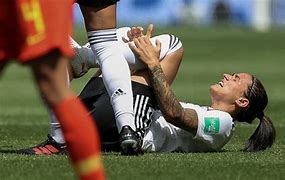While driving around town the other day my ear picked up at a story on the radio, and it occurred to me that it might be of interest to my daughter Sal and my son’s partner Gracey who both happen to be good athletes and very good soccer* players. Daughter Jade, a hooper, might also take note. I saw Gracey (who just happens to have a crook knee) the next day and I told her about this new research.
“Nah… that’s crap,” she said. “No way.”
Noting Grace’s disbelief, it occurred to me that the subject might be worth a closer look. So… I googled up ABC stories and I found the article/story. I also checked out a few other web sites on the subject. In summary, this is what I discovered.
Risk factors associated with ACL injuries? Would you believe bra choice might play a part?
The anterior cruciate ligament, (ACL is a piece of dense connective tissue that runs diagonally through the middle of the knee), is a critical element of the joint’s stabilizing mechanics. Tearing or rupturing the ligament is not only excruciatingly painful but can also mean many months of rehab and, often, surgical intervention. Worryingly, women seem to experience such injuries far more often than men. There is currently a plague of such injuries in women’s soccer*, netball, and basketball.
As the number of women participating in professional and recreational sports continues to increase, so is the number of women suffering debilitating ACL injuries. Sports medicine physicians/physios, scientists, researchers, and sports administrators (as well as athletes themselves) have reacted with alarm and sought to understand why female athletes appear to be at greater risk than their male counterparts. Until recently training methods and biological factors have been the primary areas of research conducted in an effort to get to the bottom of why women suffer this particular injury so frequently.
Surprise risk factor

Recent research published in the Journal of Applied Biometrics, however, has identified a new risk factor for female athletes. The study indicates that poorly supported breasts can add significant stress to the knee joint. The researchers found that wearing a well-fitted sports bra decreases the amount of knee flexion and dynamic knee valgus (the inward turning of the knee above the foot) when carrying out running, jumping and sudden stopping movements. The increased knee stability associated with these improved dynamics reduces the risk of serious knee injury.
The study also found that women tend to adopt an ankle-dominant strategy on landing when they have poor breast support (placing more pressure on the ACL) but move to a more hip-dominant strategy when wearing a well-fitted sports bra (relieving the ACL pressure). The supporting effect of the sports bra stabilizes and reduces movement in the trunk… which, in turn, enables easier control of the pelvis which influences the controlled movement of the thighs. Creating controlled thigh and hip movement (in contrast to relying on an ankle-dominant approach to managing foot landing) should help to reduce the risk of serious knee injuries in women.
Increase performance
Wearing a decent sports bra is not only about helping to prevent injury. Recent studies have also shown that properly fitted, supportive, bras can also help to increase performance. Researchers argue that well-fitted sports bras can achieve the following positive outcomes…
- Improved running economy through reduced oxygen consumption
- Decrease ground reaction force
- Improved running posture
- Less tense trunk
- Longer strides
- Less distraction and discomfort
Researchers at Portsmouth University in the United Kingdom have even suggested that the above factors can mean several minutes difference in a woman’s performance over a marathon!
Interesting, huh? For all you who have Graces and Sals among your relatives and friends pass the word on. Wearing a good quality, well-fitted, sports bra might not be the whole story (because there are many other factors… anatomical, biomechanical and hormonal for instance… that may cause women to have a higher incidence of ACL problems) but if it even lessens the risk a little bit it’s worth knowing about… especially since it might even improve their athletic performance to some degree.
For more info, start by checking out the story at the ABC Radio National site
*I don’t apologise for my use of the term soccer to describe Association Football because, in the world where I live, readers from Victoria and South Australia associate the term “football” with Australian Football, residents of NSW and Queensland consider “football” to mean Rugby League, Americans think “football” is American Football and people who send their kids to G.P.S schools think that “football” is Rugby. So… in the interests of all round clear communication, soccer it is!


Leave a Reply